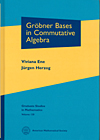- About MAA
- Membership
- MAA Publications
- Periodicals
- Blogs
- MAA Book Series
- MAA Press (an imprint of the AMS)
- MAA Notes
- MAA Reviews
- Mathematical Communication
- Information for Libraries
- Author Resources
- Advertise with MAA
- Meetings
- Competitions
- Programs
- Communities
- MAA Sections
- SIGMAA
- MAA Connect
- Students
- MAA Awards
- Awards Booklets
- Writing Awards
- Teaching Awards
- Service Awards
- Research Awards
- Lecture Awards
- Putnam Competition Individual and Team Winners
- D. E. Shaw Group AMC 8 Awards & Certificates
- Maryam Mirzakhani AMC 10 A Awards & Certificates
- Two Sigma AMC 10 B Awards & Certificates
- Jane Street AMC 12 A Awards & Certificates
- Akamai AMC 12 B Awards & Certificates
- High School Teachers
- News
You are here
Gröbner Bases in Commutative Algebra

Publisher:
American Mathematical Society
Publication Date:
2012
Number of Pages:
164
Format:
Hardcover
Series:
Graduate Studies in Mathematics 130
Price:
53.00
ISBN:
9780821872871
Category:
Monograph
[Reviewed by , on ]
Felipe Zaldivar
01/16/2012
Polynomials in several variables are ubiquitous in many parts of mathematics, from algebraic geometry to optimization, control theory and coding theory. Given that, algorithms for working with them are more than welcome. The book under review introduces the most important of these algorithms, Buchberger’s algorithm for finding Gröbner bases from any set of generators of a given ideal in a polynomial ring. This is a fundamental result with many important applications ranging from deciding the equality of ideals, intersection of ideals, membership to the associated radical ideal and elimination theory, to the solution of optimization problems. With the ever-expanding use of computer tools, Buchberger’s algorithm and its variants are now part of several standard computer algebra systems such as Singular or CoCoA.
There are now several books devoted to this theory, such as Becker, Kredel and Weispfenning’s Gröbner Bases: A Computational Approach to Commutative Algebra (Springer, 1993), Adams and Loustaunau’s An Introduction to Gröbner Bases (AMS, 1994), Fröberg’s An Introduction to Gröbner Bases (Wiley, 1997) or Cox, Little and O’Shea Ideal, Varieties, and Algorithms: An Introduction to Computational Algebraic Geometry and Commutative Algebra, (Springer, 1997) and for more advanced topics, Monomial Ideals, by Herzog and Hibi (Springer, 2011).
The book under review gives a concise, well-written introduction to the theory of Gröbner bases, starting with their definition and construction in chapter two, after a few preliminaries on ideals in polynomial rings in chapter one. Chapter three gives the first applications based on the elimination of variables, such as the computation of a Gröbner basis for the intersection of two polynomial ideals or a test for membership in the radical of a given ideal. Chapter four starts with a generalization of the notion of Gröbner basis for submodules of finitely generated free modules over a polynomial ring, and ends with Schreyer’s proof of Hilbert’s Syzygy Theorem using Gröbner bases.
The next two chapters give an introduction to some topics of current interest. Semigroup rings and their toric ideals, with applications to algebraic combinatorics, are studied in chapter five, treating in some detail the case of edge rings associated to bipartite graphs. The last chapter introduces the important class of Koszul algebras and includes selected applications to more advanced topics in commutative algebra and algebraic Combinatorics, such as determinantal ideals and Young tableaux.
The topics in this chapter are carefully selected to give an overview of some aspects of current interest, perhaps not in maximum generality, but enough to guide the interested reader to more advanced monographs and research articles. The book has sets of exercises at the end of every chapter, it is almost self-contained, and can be used for a one-semester course or for self-study by a student with a standard background on algebra.
Felipe Zaldivar is Professor of Mathematics at the Universidad Autonoma Metropolitana-I, in Mexico City. His e-mail address is fz@xanum.uam.mx.
See the table of contents in pdf format.
- Log in to post comments




